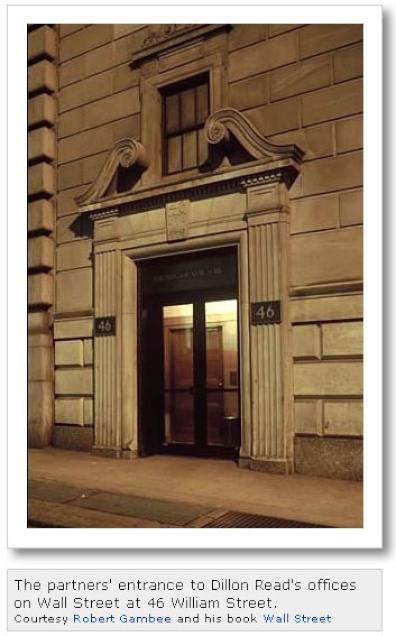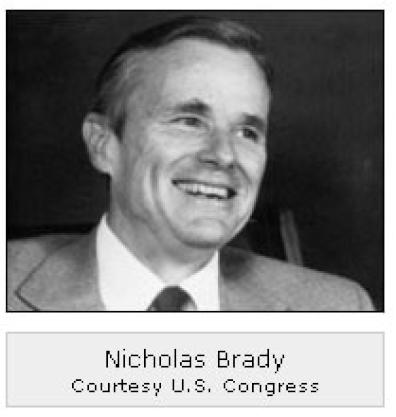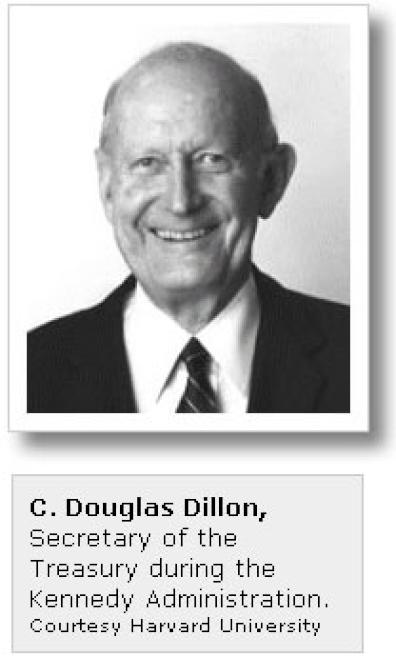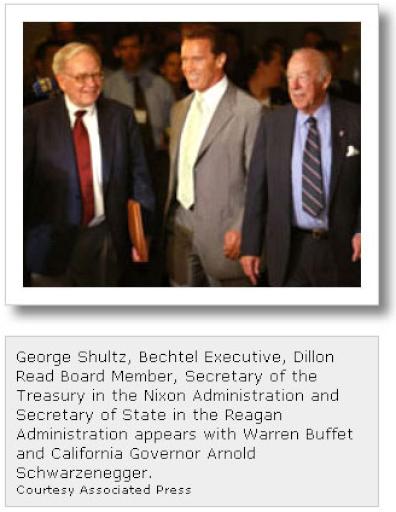Dillon Read (2): Brady Bush Bechtel & The Boys
A Serialised Story - Part 2 of 20 (publishing August/September 2007)
Dillon Read & Co. Inc.
And the Aristocracy of Stock
Profits
By Catherine Austin Fitts
Click Here For Links To Other Chapters
Chapter 1: Brady, Bush, Bechtel and "the Boys"[1]
I remember when John Birkelund first came to Dillon Read in 1981 to serve as President and Chief Operating Officer.[2] Dillon was a small private investment bank on Wall Street with a proud history and a shrinking market share as technology and globalization fueled new growth. I had joined the firm three years before and, after a period in corporate finance, had migrated to the Energy Group — helping to arrange financing for oil and gas companies who were clients of Birkelund’s predecessor, Bud Treman. Bud was a member of the old school — an ethical man increasingly frustrated with the corrupting influence of hot money and easy debt.

(* The Dillon Read photo above is licensed for website use; not for written publication.)
This was a time of transition. Dillon’s Chairman, Nicholas F. Brady, was considered one of George H. W. Bush’s most intimate friends and advisors. Both attended Yale, both were children of privilege. Bush had left his home in Greenwich Connecticut and with the help at his father’s networks at Brown Brothers Harriman had gone into oil and gas in Texas. Brady had gone to Harvard Business School and then returned to the aristocratic hunt country of New Jersey, where the Bradys and the Dillons had estates, to work at Dillon Read.
Bush climbed through Republican politics to become Director of the Central Intelligence Agency (CIA) during the Ford Administration. After spending four years displaced by the Carter Administration, Bush was now Reagan’s Vice President with Executive Order authority for the National Security Council (NSC) and U.S. intelligence and enforcement agencies. Bush’s new authority was married with expanded powers to outsource sensitive work to private contractors. Such work could be funded through the non-transparent financial mechanisms available through the National Security Act of 1947, and the CIA Act of 1949.

This was a secret source of money for funding powerful new weaponry and surveillance technology and operations owned, operated or controlled by private corporations.[3] Carter’s massive layoffs at the CIA had created plenty of private contractor capacity looking for work.[4] An assassination attempt on President Reagan’s life two months after the inauguration meant that Vice President Bush and his team were called on to play an expanded role. Meantime, Nicholas Brady continued as an intimate friend and collaborator from his position as Chairman of Dillon Read.[5]
In April of 1981, Bechtel, working through the Bechtel private venture arm Sequoia, bought the controlling interest in Dillon Read from the Dillon family, led by C. Douglas Dillon, former U.S. Treasury Secretary[6] and son of the firm’s namesake, Clarence Dillon. This was a time when Bechtel was facing increased competition globally while experiencing a decline in the nuclear power business that they had pioneered.[7]

We found ourselves with new owners whose operations were an integral part of the military and intelligence communities and who had demonstrated a rapacious thirst for drinking from the federal money spigot.[8] George Schultz, former Secretary of the Treasury during the Nixon Administration, and now Bechtel executive, joined our board.
Unusual things started to happen that were very “un-Dillon-Ready-like.” First came a new bluntness. I will never forget the day that one of the partners brought around a very charming retired senior Steve Bechtel to tour the firm. Upon introduction, he peered up at me through thick glasses and said “Far out, a chick investment banker.” Then came strategic planning with SRI International, the think tank offshoot of Stanford University that had long standing relationships with the Bechtel family and Schultz. The head of the Energy Group that I worked for at the time was part of the planning group. His mood changed during this period and he later left the firm, retiring from the industry. Before going he warned me that I should do the same. He never said why…leaving a chill that I have felt many times since as ominous changes continue that have no name or a face.

The planning group recommended that we expand our business into merchant banking. This means managing money in venture investment by starting and growing new companies or taking controlling interests in existing companies, including “leveraged buy-outs.”[9] Rather than serving companies who needed to raise money by issuing securities, or make markets in existing securities, we were going to start raising money so we could create, buy and trade companies. A company was no longer a customer. They were now a target. Wall Street was its own customer who would raise money to buy companies who would work for us. This required new people with new skills.
FOOTNOTES[1] "The Boys" is a nickname used to refer to the CIA and/or the U.S. intelligence community.
[2] The Life and Times of Dillon Read, Robert Sobel, Truman Talley Books/Dutton, 1991 (LINK).
[3] See The Negative Return on Investment Economy—A Discourse on America’s Black Budget by Chris Sanders and Catherine Austin Fitts (http://www.solariactionnetwork.com/phpBB2/viewtopic.php?p=3771#3771), World Affairs Journal. See also, Tim Weiner, Blank Check: The Pentagon’s Black Budget, New York, Warner Books, 1991 ( LINK ).
[4] Carter’s Director of CIA, Admiral Stansfield Turner, fired over 800 covert operators. This "piratization" of covert is said to have created a significant infrastructure of private intelligence operatives, including a group called "The Company." In Barry & 'the boys': The CIA, the Mob and America’s Secret History, Mad Cow Press, 2001, pages 234-235 and 404 ( LINK ), Daniel Hopsicker writes:
“After Carter takes over in 1976 and Admiral Stansfield Turner cleans house at the CIA, finding jobs for long time CIA assets like (Barry) Seal became a priority that was often fulfilled by smuggling under color of narcotics interdiction,” stated Hemming. “All these guys had to be placed somewhere after that choirboy Admiral started getting rid of them. The majority of the operators that were contract employees had to be placed somewhere. There had to be money to take care of these guys. Hemming is referring to what “Deadly Secrets” calls Turners Great Terror when the new CIA Director purged over 800 covert operatives after the Congressional revelations of the CIA’s dirty laundry by the Church and Pike Committees investigations. These investigations, which then-CIA Director Bush fought every step of the way, led directly to the election of (Carter). Even…General Manuel Noriega was let go in the purge, it was a sign of the desperation of the times. And it prompted droves of angry CIA cowboys to enlist in the George Bush for President Campaign, where their unofficial campaign slogan must have been “Never ever again.”.....
Headquartered outside of St. Louis, “The Company” launched in 1976 and grew into an enterprise with over 350 employees, with separate executives in charge of buying airports, leasing warehouses and even giving polygraph tests to new employees. There was even a $2 million fund for bail. In just two years, The Company had acquired 33 airplanes, 3 airports, warehouses in 7 states and profits of $48 million. 1976 was the year that Barry Seal’s drug smuggling career began according to his wife.
When the DEA busted them… “they had secret radio frequencies of federal, state and local authorities,” a DEA spokesman said. “They had mechanical programmers and night-viewing devices. They had air-to-ground radios so sophisticated we don’t even have them on our airplanes.”
[5] See various references in Tarpley & Chaitken, The Unauthorized Biography, including a reference to Brady’s meeting with Bush, Oliver North and Felix Rodriguez in the White House (http://www.tarpley.net/bush18.htm and http://www.tarpley.net/bushb.htm):
“1986-Vice President Bush and his staff met in the White House with Felix Rodriguez, Oliver North, financier Nicholas Brady, and the new U.S. ambassador to El Salvador, Edwin Corr.”
[6] Dillon had helped Donovan found the OSS. Not surprisingly, Dillon Read also had numerous ties, like most Wall Street firms, with the intelligence community. See The Life and Times of Dillon Read, Robert Sobel, Truman Talley/Dutton, 1991.
[7] See the description of Stephen Bechtel, Jr., Chairman of Bechtel and his concern for the outlook for Bechtel’s business on his way to the Bohemian Group—he is in the Mandalay Camp—most esteemed of The Grove’s 127 encampments as reported in Friends in High Places: The Bechtel Story—The Most Secret Corporation and How It Engineered the World, Laton McCartney, Ballentine Books, 1988, pps. 12-16 ( LINK ). Mandalay’s attendance that year is described as follows:
“It’s membership and guest list included Steve, his father, Stephen D. Bechtel, Sr.; Henry Kissinger; former Bechtel Group President and Secretary of State designate George P. Schultz (who this year was bringing West German Chancellor Helmut Schmidt as his personal guest); former IBM chairman and U.S. Ambassador to the Soviet Union Thomas J. Watson; former CIA director John A McCone (former Bechtel partner); Attorney General William French Smith (who had just signed the MOU three months earlier relieving the CIA of the need to report drug dealing by its networks); industrialist Edgar F. Kaiser, Jr.; former Nixon political aide Peter M. Flanigan; Pan American World Airways’ onetime boss Najeeb Halaby; Wells Fargo Bank Chairman Richard P. Cooley; former General Electric chairman Philip D. Reed; Southern California Edison chairman J.K. "Jack" Horton; Utah International Chairman Edmund W. Littlefield; Dillon Read’s former boss Nicholas F. Brady, who was serving as an interim senator from New Jersey and, like Peter Flanigan, was Steve junior’s guest; tire and rubber heir Leonard K. Firestone and, not least, Gerald Ford, the former President of the United States. In addition, this year’s encampment would feature such notables as former Secretary of State Alexander Haig, FBI Director William Webster; computer magnate (and former deputy Defense secretary) David Packard; Chief of Naval Operations Thomas Hayward; Eastern Airlines president Frank Borman; Federal Reserve Bank chairman Paul Volker; World Bank president Alden W. Clausen; Union Oil Chairman Fred L. Hartley; Atlantic Richfield Chairman Robert O. Anderson; publishing czar William Randolph Hearst, Jr.; Southern Pacific Railroad president Alan C. Furth; show business personalities Charlton Heston, Art Linkletter and Dennis Day; and including, among various other pooh-bahs, the Presidents of Dean Witter Reynolds the Bank of America and United Airlines…Page 16 describes problems Bechtel is facing…Confronted with a recession, declining oil prices and stiffer competition abroad…and how George Schultz, former Bechtel President and now Secretary of State will be at the Grove to help…”
[8] Friends in High Places: The Bechtel Story—The Most Secret Corporation and How It Engineered the World by Laton McCartney, Ballentine Books, 1988.
[9] See Leveraged Buy-Out in Wikipedia (http://en.wikipedia.org/wiki/Leveraged_buyouts).
 Mapping The Real Deal is a column on
Scoop supervised by Catherine Austin Fitts. Ms Fitts is the
President of Solari, Inc. http://www.solari.com/. Ms. Fitts is
the former Assistant Secretary of Housing-Federal Housing
Commissioner during the first Bush Administration, a former
managing director and member of the board of directors of
Dillon Read & Co. Inc. and President of The Hamilton
Securities Group,
Inc.
Mapping The Real Deal is a column on
Scoop supervised by Catherine Austin Fitts. Ms Fitts is the
President of Solari, Inc. http://www.solari.com/. Ms. Fitts is
the former Assistant Secretary of Housing-Federal Housing
Commissioner during the first Bush Administration, a former
managing director and member of the board of directors of
Dillon Read & Co. Inc. and President of The Hamilton
Securities Group,
Inc.


 Keith Rankin: Geopolitical Fractures, And Untidy Yet Workable Solutions
Keith Rankin: Geopolitical Fractures, And Untidy Yet Workable Solutions Gordon Campbell: On Winston Peters’ Battle Against The Phantom Legions Of The Woke
Gordon Campbell: On Winston Peters’ Battle Against The Phantom Legions Of The Woke Adrian Maidment: Road Cone Final Exam & Donald, I Warned You!
Adrian Maidment: Road Cone Final Exam & Donald, I Warned You! Binoy Kampmark: The Script Of Anxiety - Poland’s Nuclear Weapons Fascination
Binoy Kampmark: The Script Of Anxiety - Poland’s Nuclear Weapons Fascination Martin LeFevre - Meditations: Regarding Randomness And Significance
Martin LeFevre - Meditations: Regarding Randomness And Significance Ian Powell: When Apartheid Met Zionism
Ian Powell: When Apartheid Met Zionism